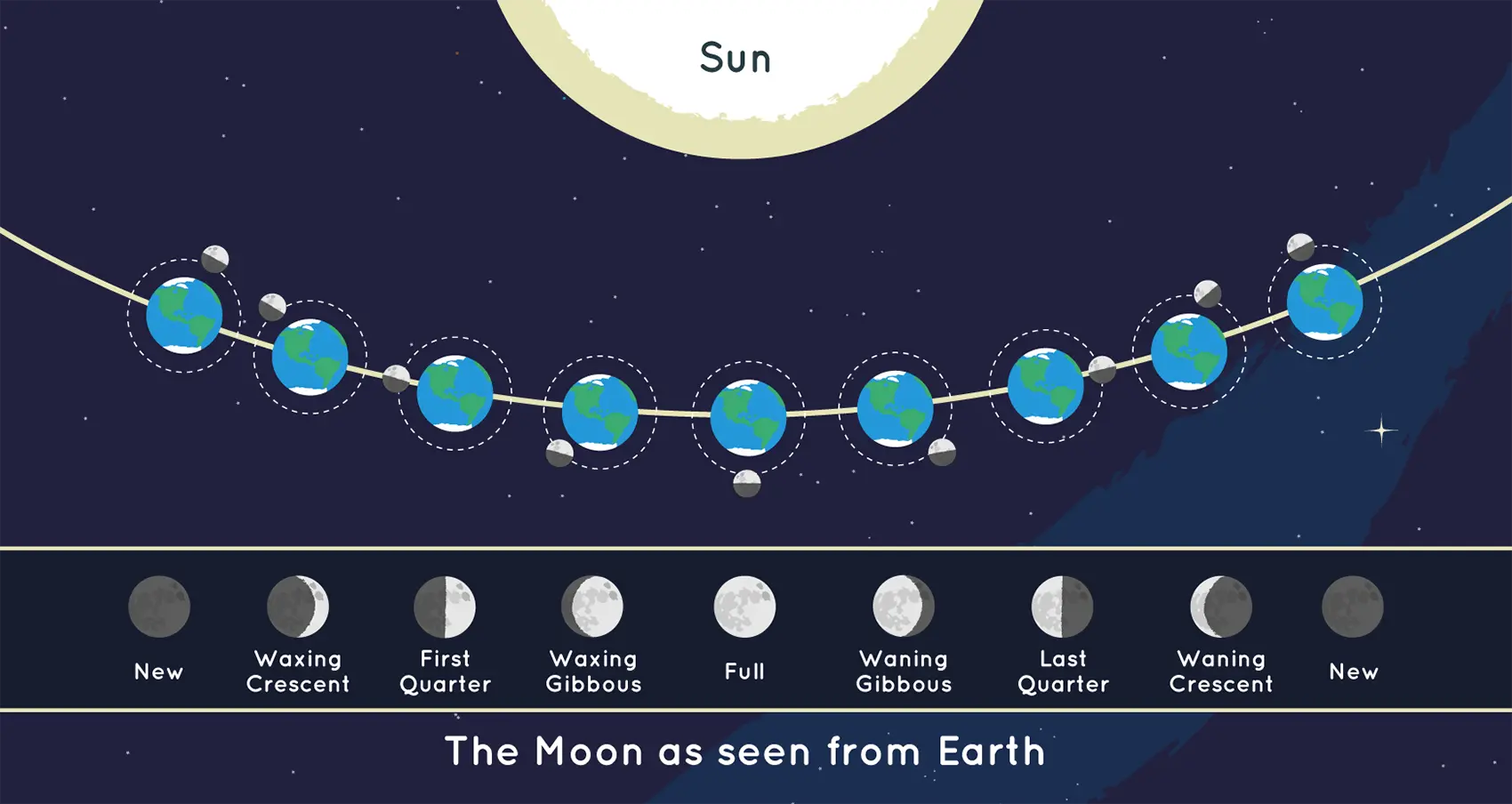If you want to learn about the moon formation, moon phases or about the different types of eclipses, then check this page.
In our entire solar system, the only object that shines with its own light is the Sun. That light always beams onto Earth and Moon from the direction of the Sun, illuminating half of our planet in its orbit and reflecting off the surface of the Moon to create moonlight.Like Earth, the Moon has a day side and a night side, which change as the Moon rotates. The Sun always illuminates half of the Moon while the other half remains dark, but how much we are able to see of that illuminated half changes as the Moon travels through its orbit.Let’s take a look at the individual phases, and how the movements of the Moon and Sun appear to us as we watch from the Northern Hemisphere on Earth:


|
New moonThis is the invisible phase of the Moon, with the illuminated side of the Moon facing the Sun and the night side facing Earth. In this phase, the Moon is in the same part of the sky as the Sun and rises and sets with the Sun. Not only is the illuminated side facing away from the Earth, it’s also up during the day! Remember, in this phase, the Moon doesn’t usually pass directly between Earth and the Sun, due to the inclination of the Moon’s orbit. It only passes near the Sun from our perspective on Earth. |

|
Waxing CrescentThis silver sliver of a Moon occurs when the illuminated half of the Moon faces mostly away from Earth, with only a tiny portion visible to us from our planet. It grows daily as the Moon’s orbit carries the Moon’s dayside farther into view. Every day, the Moon rises a little bit later. |

|
First QuarterThe Moon is now a quarter of the way through its monthly journey and you see half of its illuminated side. People may casually call this a half moon, but remember, that’s not really what you’re witnessing in the sky. You’re seeing just a slice of the entire Moon ― half of the illuminated half. A first quarter moon rises around noon and sets around midnight. It’s high in the sky in the evening and makes for excellent viewing. |

|
Waxing GibbousNow most of the Moon’s dayside has come into view, and the Moon appears brighter in the sky. |

|
Full MoonThis is as close as we come to seeing the Sun’s illumination of the entire day side of the Moon (so, technically, this would be the real half moon). The Moon is opposite the Sun, as viewed from Earth, revealing the Moon’s dayside. A full moon rises around sunset and sets around sunrise. The Moon will appear full for a couple of days before it moves into… |

|
Waning GibbousAs the Moon begins its journey back toward the Sun, the opposite side of the Moon now reflects the Moon’s light. The lighted side appears to shrink, but the Moon’s orbit is simply carrying it out of view from our perspective. The Moon rises later and later each night. |

|
Last QuarterThe Moon looks like it’s half illuminated from the perspective of Earth, but really you’re seeing half of the half of the Moon that’s illuminated by the Sun ― or a quarter. A last quarter moon, also known as a third quarter moon, rises around midnight and sets around noon. |

|
Waning CrescentThe Moon is nearly back to the point in its orbit where its dayside directly faces the Sun, and all that we see from our perspective is a thin curve. |

Earthshine refers to the faint illumination of the dark portion of the moon's surface caused by sunlight reflected off the Earth. This phenomenon occurs when the Earth's surface reflects sunlight, which then travels to the moon and illuminates the portion of the moon not directly lit by the sun. Essentially, it's a dim glow on the lunar surface caused by sunlight bouncing off Earth and reaching the moon. This soft glow is often observable during the waxing or waning crescent phases of the moon when the Earth-facing side of the moon appears partly illuminated while the rest remains dimly visible due to earthshine.
Though the Moon is often thought of as a nighttime visitor, it’s also visible during the day as a faint, pale presence. The best times to see a daytime Moon are perhaps during the first and last quarter phases, when the Moon is high enough above the horizon and at about 90 degrees from the Sun in the sky. This helps make the Sun’s reflected light bright enough to see as it reflects off of the Moon. The Moon can be seen in the daylit sky at any phase except for the new moon, when it’s invisible to us, and full moon, when it’s below the horizon during the day. The crescent through quarter phases are high in the sky during the day, but the daytime gibbous phases can be glimpsed only just before the Sun sets.
